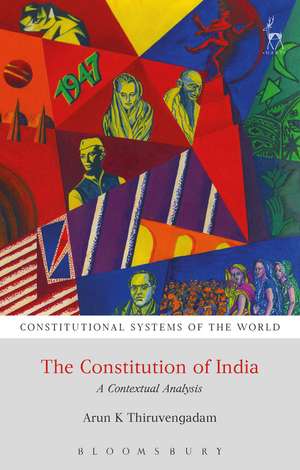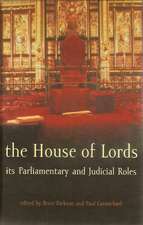The Constitution of India: A Contextual Analysis: Constitutional Systems of the World
Autor Arun K Thiruvengadamen Limba Engleză Paperback – 27 dec 2017
Din seria Constitutional Systems of the World
- 38%
 Preț: 134.64 lei
Preț: 134.64 lei - 23%
 Preț: 197.68 lei
Preț: 197.68 lei - 14%
 Preț: 147.59 lei
Preț: 147.59 lei - 34%
 Preț: 509.52 lei
Preț: 509.52 lei - 28%
 Preț: 374.41 lei
Preț: 374.41 lei - 40%
 Preț: 466.81 lei
Preț: 466.81 lei - 22%
 Preț: 263.72 lei
Preț: 263.72 lei - 23%
 Preț: 185.93 lei
Preț: 185.93 lei - 19%
 Preț: 166.82 lei
Preț: 166.82 lei - 23%
 Preț: 152.82 lei
Preț: 152.82 lei - 21%
 Preț: 218.26 lei
Preț: 218.26 lei - 23%
 Preț: 178.47 lei
Preț: 178.47 lei - 19%
 Preț: 303.62 lei
Preț: 303.62 lei - 18%
 Preț: 300.14 lei
Preț: 300.14 lei - 30%
 Preț: 510.03 lei
Preț: 510.03 lei - 14%
 Preț: 192.30 lei
Preț: 192.30 lei - 18%
 Preț: 304.66 lei
Preț: 304.66 lei - 23%
 Preț: 178.02 lei
Preț: 178.02 lei - 18%
 Preț: 225.31 lei
Preț: 225.31 lei - 23%
 Preț: 197.14 lei
Preț: 197.14 lei - 18%
 Preț: 180.44 lei
Preț: 180.44 lei - 18%
 Preț: 179.98 lei
Preț: 179.98 lei - 18%
 Preț: 186.35 lei
Preț: 186.35 lei - 14%
 Preț: 179.00 lei
Preț: 179.00 lei - 16%
 Preț: 218.47 lei
Preț: 218.47 lei - 19%
 Preț: 184.14 lei
Preț: 184.14 lei - 18%
 Preț: 297.58 lei
Preț: 297.58 lei - 16%
 Preț: 218.00 lei
Preț: 218.00 lei - 18%
 Preț: 232.54 lei
Preț: 232.54 lei - 23%
 Preț: 171.85 lei
Preț: 171.85 lei - 18%
 Preț: 225.49 lei
Preț: 225.49 lei - 14%
 Preț: 185.93 lei
Preț: 185.93 lei - 13%
 Preț: 230.79 lei
Preț: 230.79 lei - 13%
 Preț: 186.10 lei
Preț: 186.10 lei - 19%
 Preț: 179.10 lei
Preț: 179.10 lei -
 Preț: 223.20 lei
Preț: 223.20 lei - 18%
 Preț: 180.44 lei
Preț: 180.44 lei -
 Preț: 217.09 lei
Preț: 217.09 lei - 18%
 Preț: 186.35 lei
Preț: 186.35 lei
Preț: 174.07 lei
Preț vechi: 201.06 lei
-13% Nou
Puncte Express: 261
Preț estimativ în valută:
33.31€ • 34.87$ • 27.56£
33.31€ • 34.87$ • 27.56£
Carte disponibilă
Livrare economică 15-29 martie
Livrare express 01-07 martie pentru 55.92 lei
Preluare comenzi: 021 569.72.76
Specificații
ISBN-13: 9781841137360
ISBN-10: 1841137367
Pagini: 296
Dimensiuni: 138 x 216 x 19 mm
Greutate: 0.43 kg
Editura: Bloomsbury Publishing
Colecția Hart Publishing
Seria Constitutional Systems of the World
Locul publicării:London, United Kingdom
ISBN-10: 1841137367
Pagini: 296
Dimensiuni: 138 x 216 x 19 mm
Greutate: 0.43 kg
Editura: Bloomsbury Publishing
Colecția Hart Publishing
Seria Constitutional Systems of the World
Locul publicării:London, United Kingdom
Caracteristici
It will also appeal widely to constitutional lawyers, particularly those with an interest in Indian and South Asian constitutionalism, and comparative constitutional law.
Notă biografică
Arun K Thiruvengadam is a Professor of Law at the School of Policy and Governance, Azim Premji University, Bengaluru, India.
Cuprins
INTRODUCTIONI. The Constitution of India and Its Special Significance II. Approach and Orientation of the Book III. Brief Outline of Chapters 1. ORIGINS AND CRAFTING OF THE CONSTITUTION I. Introduction II. The Mughals and the East India Company (1550-1857) III. The British Raj and Colonial Forms of Constitutional Government (1858-1947)-A Bird's Eye View IV. The Nationalist Movement and the Build-up of Attempts at Constitution Making (1895-1947)-A Worm's Eye View V. Crafting a Constitution for Independent India: The Work of the Constituent Assembly VI. Conclusion Further Reading 2. THE EXECUTIVE AND PARLIAMENT I. Introduction II. Brief Overview of Relevant Constitutional Provisions III. Pre-history, Colonial Experiences and Debates within the Constituent Assembly IV. Brief Overview of Evolution of the Indian Political Landscape through the Prism of Electoral Resultsand Party Politics V. The Changing Role of Parliament in Indian Constitutional Democracy VI. Significant Judicial Pronouncements on Constitutional Provisions Relating to the Executive and Parliament VII. Conclusion Further Reading 3. FEDERALISM AND LOCAL GOVERNMENT I. Introduction II. The Colonial Period and Its Influence on Later Constitutional Developments Relating to Federalismand Local Government III. Understanding the Centralising Bias within the Constituent Assembly IV. The Structure and Content of Provisions in the Indian Constitution on Federalism and their EvolutionOver Time V. The Structure and Content of Provisions in the Indian Constitution on Local Government and theirEvolution Over Time VI. Conclusion Further Reading 4. FUNDAMENTAL RIGHTS, DIRECTIVE PRINCIPLES AND THE JUDICIARY I. Introduction II. Relevant Constitutional Provisions: Textual Categorisation and Analysis III. The Constitutional History of Provisions Relating to Fundamental Rights, Directive Principles and theJudiciary IV. The Supreme Court and Its Role as Guardian of the Rights Provisions (1950-2016) V. The Crisis of Backlog and Delay in the Indian Judiciary VI. Conclusion Further Reading 5. TECHNOCRATIC CONSTITUTIONAL INSTITUTIONS I. Introduction II. Reflecting on the Motivations of the Framers for Entrenching Technocratic Constitutional Institutions III. The Office of the Comptroller and Auditor General IV. The Election Commission of India V. The Introduction of New Regulatory Institutions in the Aftermath of the Constitutional Moment of 1991 VI. Conclusion Further Reading 6. CONSTITUTIONAL REGULATION OF INDIA'S MULTIPLE IDENTITIES I. Introduction II. Relevant Constitutional Provisions III. Relevant Constitution-making History IV. Post-independence Evolution of the Law on the Markers of Indian Identity V. Conclusion Further Reading 7. CONSTITUTIONAL CHANGE I. Introduction II. Relevant Constitutional Provisions and Constitutional History III. Constitutional Practice in Relation to the Amending Power in India: An Overview and Analysis of Trends(1950-2016) IV. Constitutional Interpretation as a Source of Constitutional Change V. Constitutional Change through Constitutional Moments VI. Conclusion Further Reading CONCLUSION I. Introduction II. A Brief Overview of Prime Minister Modi's Tenure (2014-17) through a Constitutional Lens III. Assessing India's Constitutional Trajectory Across Seven Decades (1947-2017) IV. Concluding Reflections Further Reading
Recenzii
... unlike other legal scholarship, the book is written in crisp language. Anyone seriously interested in the working of India's institutions must not miss this one.
[T]hough the book is written for the international audience, it is of equal interest to accomplished Indian constitutional scholars... It is a smooth read, sustaining continued interest in going through it. For all these qualities of the book the author must be congratulated.
The Hart/Bloomsbury series on contextual analyses of national constitutions has been going from strength to strength. The present volume, focusing on India, offers an accessible introduction to one of the longest and most amended constitutions in the world.
This book is a recommended read for academics of constitutional law, students, researchers and anyone who is keen to understand the underpinnings of the Indian constitutional system. It introduces the reader to the rollercoaster ride of India's constitutional journey through darker times. Woven together in a narrative form and written in accessible prose, it keeps the reader engaged throughout.
Thiruvengadam's book is a valuable resource for students and scholars of constitutional law, especially those keen on understanding the subject beyond the realm of the courts.
Thiruvengadam casts his net beyond a small set of constitutional provisions that are usually discussed and throws welcome light on the history of these provisions . [He] provides an excellent introduction to the Constitution . [and] also has a welcome chapter on constitutional change and the practice of constitutional amendment.
[T]hough the book is written for the international audience, it is of equal interest to accomplished Indian constitutional scholars... It is a smooth read, sustaining continued interest in going through it. For all these qualities of the book the author must be congratulated.
The Hart/Bloomsbury series on contextual analyses of national constitutions has been going from strength to strength. The present volume, focusing on India, offers an accessible introduction to one of the longest and most amended constitutions in the world.
This book is a recommended read for academics of constitutional law, students, researchers and anyone who is keen to understand the underpinnings of the Indian constitutional system. It introduces the reader to the rollercoaster ride of India's constitutional journey through darker times. Woven together in a narrative form and written in accessible prose, it keeps the reader engaged throughout.
Thiruvengadam's book is a valuable resource for students and scholars of constitutional law, especially those keen on understanding the subject beyond the realm of the courts.
Thiruvengadam casts his net beyond a small set of constitutional provisions that are usually discussed and throws welcome light on the history of these provisions . [He] provides an excellent introduction to the Constitution . [and] also has a welcome chapter on constitutional change and the practice of constitutional amendment.










